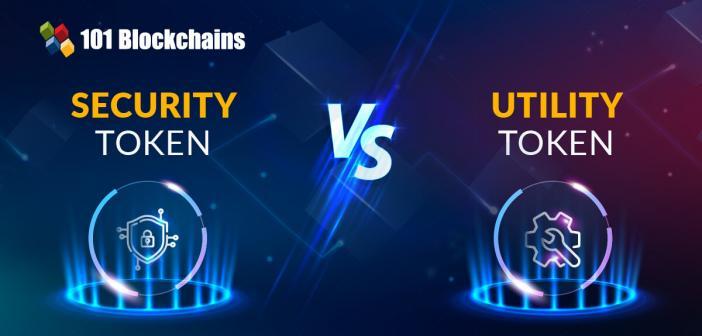Learn how blockchain truly works, master key definitions, and uncover what makes smart contracts so "smart." Dive into the fundamentals, gain valuable insights, and start your blockchain journey today!

- Guides
101 Blockchains
- on June 28, 2018
Security token vs utility token: A comparison
Whether you are an Initial Coin Offering (ICO) investor or a blockchain-crypto entrepreneur, you need to the understand security token vs utility token differences. If you invest without realizing the differences, then your funds could be stuck for a long time. If, as an entrepreneur, you launch your ICO without understanding the differences, you could face regulatory issues. I will explain the security token vs utility token differences here, however, let’s understand the context first.
Lack of ICO regulations pose challenges to investors and start-ups:
I have earlier explained the unregulated nature of ICOs in this article “What is an ICO: An introduction to Initial Coin Offering”. While ICOs have democratized investment and enabled start-ups to raise money quickly without long-drawn regulatory requirements, they also pose risks: For e.g.:
- In the US, only individuals with over US $ 1 million semi-liquid net worth can become accredited investors. The other option is if they have had US $ 200k annual income for at least 2 years. The threshold is US $ 300k for families. It has certain implications, for e.g.:
- While this rules many people out of the investment market, it also protects small investors from high-risk investment avenues. The small investors can still invest in mutual fund or secondary markets, which have a lower risk.
- However, ICOs have opened the world of investment to the small investors, and they are now exposed to even Pyramid schemes that have launched ICOs! Pyramid schemes recruit new members promising them payment if they enroll others. There are no products or service. The schemes quickly collapse and small investors lose their money. These schemes are illegal in many countries. Read more about it in this Wikipedia article “Pyramid scheme”.
- ICOs became popular very quickly, as I have explained in my introduction to ICO article. Regulators haven’t yet put their arms around ICOs, while blockchain-crypto start-ups have gone ahead with legally questionable offerings. Now when regulators are scrutinizing ICOs, the future of many blockchain-crypto projects are uncertain.
The grey area of security token vs utility token is one such glaring example of risks that unregulated ICOs pose. To understand the risk better, we first need to differentiate between cryptocurrency coins and tokens.
Crypto coins vs tokens differences have a direct bearing on unregulated ICOs:
Cryptocurrencies can be coins, and they can be tokens. A cryptocurrency like Bitcoin has a primary use case of facilitating payment transactions in a decentralized network. Bitcoin also has its’ own blockchain. Bitcoin is a coin and not a token. To learn more about Bitcoin, read this article “Blockchain vs Bitcoin: Are They Different?“.
Ether runs on its’ own blockchain, i.e. Ethereum network. Although Ethereum has other prominent use cases, payment is indeed a key use case of Ether. Ether is also a coin. Similarly, Ripple is a coin too. If the primary or prominent use case of a cryptocurrency is payment, and it runs on its’ own blockchain, that’s a coin.
On the other hand, if the primary use case is something other than payment and the cryptocurrency runs on another blockchain, it’s a token. Take the example of Golem Project, which runs on the Ethereum network. While you need to use Golems’ cryptocurrency GNT in their DApp, the underlying platform has its native cryptocurrency, i.e. Ether. Hence, GNT is a crypto token, not a coin.
ICOs sell tokens and the risk of unregulated ICOs center around tokens. This is an important context to understand before you can appreciate the security token vs utility token differences. Coins aren’t securities, but tokens can be.
Want to become a Cryptocurrency expert? Enroll Now in Cryptocurrency Fundamentals Course
What are securities in investment?
Securities in investment are tradable financial assets like equities and fixed income instruments. Investors buy them with an expectation of future profit, while they also get a stake in the company.
These are heavily regulated, for e.g. the Securities and Exchange Commission (SEC) regulates them. SEC uses the ‘Howey Test’ to determine if an investment contract is a security. A securities instrument must meet the following two conditions:
- One buys it expecting a future profit;
- One entity is in charge of it, and it’s not governed by a democratic network governance model.
SEC subjects a securities instrument to many regulatory requirements, for e.g.:
- Any person or organization dealing with securities must register with SEC, and failure to do so may result in lawsuits, fines, or imprisonment;
- The organization must follow SEC-mandated reporting and disclosure requirements;
- The issuer of securities must follow ‘know-your-customer’ (KYC) and ‘anti-money laundering’ (AML) requirements;
- SEC will oversee all dealings in securities and the organizations are responsible to prevent malpractices like ‘insider trading’;
- There are restrictions on transacting in securities, which limits liquidity.
Aspiring to become an certified ethical web3 hacker? Enroll now in Certified Web3 Hacker (CW3H) Course!
Security token vs utility token: the reality of ICOs
Blockchain-crypto start-ups sell crypto tokens in ICOs that they are issuing, i.e. they are in charge, and not any democratic network governance. All ICO tokens fulfill the 2nd condition of the Howey Test.
Most ICOs also sell tokens with a promise of future profit, in fact, this is often a prominent feature of their online marketing. This fulfills the 1st condition of Howey Test, which makes these security tokens.
Utility tokens are the ones with a specific utility, i.e. it gives the owner access to the company’s product or service. Siacoin is a good example of a utility token because the token holder gets access to the Sia Network, i.e. their decentralized cloud storage network. While Siacoin may appreciate, future profit isn’t the primary purpose of this token.
ICOs that sold their tokens with the promise of future profit have dealt in securities, but they haven’t offered any stake to their company. They have not registered with regulatory bodies like SEC, and haven’t fulfilled the reporting and disclosure requirements. These start-ups have disguised their tokens as utility tokens. They offer liquidity through crypto exchanges, which is another violation of securities regulation!
There’s more! Many ICOs have sold even genuine utility tokens aggressively marketing them with a promise of future profit. Regulatory agencies work on the premise of ‘substance over form’ and they will treat even these genuine utility tokens as securities now!
Build your identity as a certified blockchain expert with 101 Blockchains’ Blockchain Certifications designed to provide enhanced career prospects.
Regulators clamp down on non-compliant ICOs:

Regulators have noticed these irregularities, and are acting on them, for e.g.:
- In the US, the SEC has already sent subpoenas to 80 blockchain-crypto start-ups for suspected violations of securities regulations.
- They have put non-compliant ICOs like Tezos and Centra on notice.
- More importantly, the SEC is also examining existing projects. For e.g. they have asked several questions to ICONOMI. The company is yet to clarify their position to the regulator.
The investors who bought these tokens may find their fund stuck for a significant time period while litigations go on. Start-ups involved have already acquired a negative reputation and they may find it hard to bounce back into the blockchain-crypto space.
SEC compliant ICO is possible, and is the best way forward:
Blockchain start-ups can launch compliant ICOs, and not rely on the short-cut of declaring their security tokens as utility ones! The following start-ups have taken steps to launch ICOs that comply with regulations:
- tZero: It’s a blockchain platform for capital markets;
- Polymath: They tokenize securities using their blockchain network;
- Corl: A blockchain start-up facilitating small business and start-up funding.
Whether you are an investor or an entrepreneur, you need to understand the security token vs utility token difference. This will help you in growing the blockchain-crypto ICO ecosystem sustainably. Reporting securities token as utility token isn’t a good business practice, and is certainly not sustainable. The short-term cost of registration, KYC, AML, reporting, and disclosure is far preferable for the long-term growth of the blockchain-crypto ICO ecosystem.
While ICOs have democratized investment, the truth is that the institutional investors will not enter a field where misreporting of investment instruments is common. Read more about this risk in the article “ICO vs IPO: What’s the real Difference?“. The crypto ecosystem should proactively self-regulate while the regulators come with the regulatory framework for this exciting and promising sector. Let’s learn the technology and regulations together to grow the blockchain-crypto space sustainably!
*Disclaimer: The article should not be taken as, and is not intended to provide any investment advice. Claims made in this article do not constitute investment advice and should not be taken as such. 101 Blockchains shall not be responsible for any loss sustained by any person who relies on this article. Do your own research!






